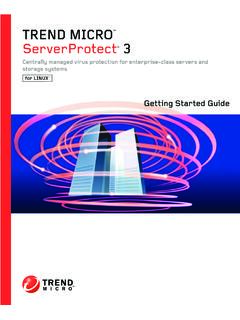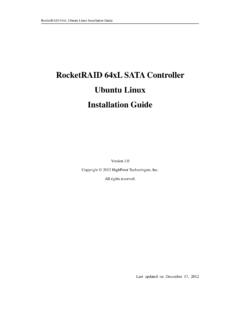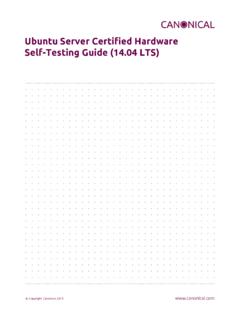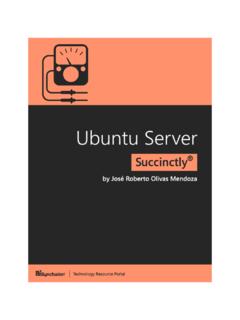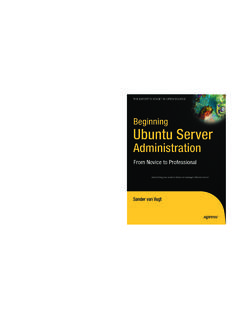Transcription of Ubuntu Server Guide - {0,1,2,3,4}
1 Ubuntu & Server & Guide & Server GuideCopyright 2014 Contributors to the documentAbstractWelcome to the Ubuntu Server Guide ! It contains information on how to install and configure various serverapplications on your Ubuntu system to fit your needs. It is a step-by-step, task-oriented Guide for configuringand customizing your and LicenseThis document is maintained by the Ubuntu documentation team ( ). A list of contributors document is made available under the Creative Commons ShareAlike License (CC-BY-SA).You are free to modify, extend, and improve the Ubuntu documentation source code under the terms of this license. All derivative worksmust be released under this documentation is distributed in the hope that it will be useful, but WITHOUT ANY WARRANTY; without even the implied warrantyof MERCHANTABILITY or FITNESS FOR A PARTICULAR PURPOSE AS DESCRIBED IN THE copy of the license is available here: Creative Commons ShareAlike to this document are: Members of the Ubuntu Documentation Project2 Members of the Ubuntu Server Team3 Contributors to the Community Help Wiki4 Other contributors can be found in the revision history of the serverguide5 and Ubuntu -docs6 bzr branches available on ~ Ubuntu -core-doc3 ~ Ubuntu -server4 of Contents1.
2 Introduction .. 11. Support .. 22. Installation .. 31. Preparing to Install .. 42. Installing from CD .. 63. Upgrading .. 94. Advanced Installation .. 105. Kernel Crash Dump .. 173. Package Management .. 201. Introduction .. 212. dpkg .. 223. Apt-Get .. 234. Aptitude .. 255. Automatic Updates .. 276. Configuration .. 297. References .. 314. Networking .. 321. Network Configuration .. 332. TCP/IP .. 423. Dynamic Host Configuration Protocol (DHCP) .. 464. Time Synchronisation with NTP .. 495. DM-Multipath .. 511. Device Mapper Multipathing .. 522. Multipath Devices .. 553. Setting up DM-Multipath Overview .. 584. The DM-Multipath Configuration File .. 625. DM-Multipath Administration and Troubleshooting .. 746. Remote Administration .. 791. OpenSSH Server .. 802. Puppet .. 833. Zentyal .. 867. Network Authentication .. 901. OpenLDAP Server .
3 912. Samba and LDAP .. 1173. Kerberos .. 1234. Kerberos and LDAP .. 1318. Domain Name Service (DNS) .. 1381. Installation .. 1392. Configuration .. 1403. Troubleshooting .. 146 Ubuntu Server Guideiv4. References .. 1509. Security .. 1511. User Management .. 1522. Console Security .. 1583. Firewall .. 1594. AppArmor .. 1665. Certificates .. 1706. eCryptfs .. 17510. Monitoring .. 1771. Overview .. 1782. Nagios .. 1793. Munin .. 18311. Web Servers .. 1851. HTTPD - Apache2 Web Server .. 1862. PHP5 - Scripting Language .. 1943. Squid - Proxy Server .. 1964. Ruby on Rails .. 1985. Apache Tomcat .. 20012. Databases .. 2041. MySQL .. 2052. PostgreSQL .. 21013. LAMP Applications .. 2131. Overview .. 2142. Moin Moin .. 2153. MediaWiki .. 2174. phpMyAdmin .. 2195. WordPress .. 22114. File Servers .. 2241. FTP Server .. 2252. Network File System (NFS).
4 2293. iSCSI Initiator .. 2314. CUPS - Print Server .. 23415. Email Services .. 2371. Postfix .. 2382. Exim4 .. 2463. Dovecot Server .. 2494. Mailman .. 2515. Mail Filtering .. 25716. Chat Applications .. 2641. Overview .. 2652. IRC Server .. 2663. Jabber Instant Messaging Server .. 268 Ubuntu Server Guidev17. Version Control System .. 2701. Bazaar .. 2712. Git .. 2723. Subversion .. 2754. References .. 28018. Samba .. 2811. Introduction .. 2822. File Server .. 2833. Print Server .. 2864. Securing File and Print Server .. 2885. As a Domain Controller .. 2936. Active Directory Integration .. 29719. Backups .. 2991. Shell Scripts .. 3002. Archive Rotation .. 3043. Bacula .. 30720. Virtualization .. 3121. libvirt .. 3132. Cloud images and uvtool .. 3183. Ubuntu Cloud .. 3224. LXC .. 32321. Control Groups .. 3381. Overview.
5 3392. Filesystem .. 3403. Delegation .. 3414. Manager .. 3425. Resources .. 34322. Clustering .. 3441. DRBD .. 34523. VPN .. 3481. OpenVPN .. 34924. Other Useful Applications .. 3621. pam_motd .. 3632. etckeeper .. 3653. Byobu .. 3674. References .. 369A. Appendix .. 3701. Reporting Bugs in Ubuntu Server Edition .. 371viList of Recommended Minimum Requirements .. Priority Checker Conversion .. DM-Multipath Components .. Multipath Configuration Defaults .. Multipath Attributes .. Device Attributes .. Useful multipath Command Options .. Access Methods .. 2761 Chapter 1. IntroductionWelcome to the Ubuntu Server Guide !Here you can find information on how to install and configure various Server applications. It is a step-by-step, task-oriented Guide for configuring and customizing your Guide assumes you have a basic understanding of your Ubuntu system.
6 Some installation detailsare covered in Chapter 2, Installation [p. 3], but if you need detailed instructions installingUbuntu please refer to the Ubuntu Installation HTML version of the manual is available online at the Ubuntu Documentation SupportThere are a couple of different ways that Ubuntu Server Edition is supported, commercial supportand community support. The main commercial support (and development funding) is available fromCanonical Ltd. They supply reasonably priced support contracts on a per desktop or per Server more information see the Canonical Services3 support is also provided by dedicated individuals, and companies, that wish to makeUbuntu the best distribution possible. Support is provided through multiple mailing lists, IRCchannels, forums, blogs, wikis, etc. The large amount of information available can be overwhelming,but a good search engine query can usually provide an answer to your questions.
7 See the UbuntuSupport4 page for more 2. InstallationThis chapter provides a quick overview of installing Ubuntu LTS Server Edition. For moredetailed instructions, please refer to the Ubuntu Installation Preparing to InstallThis section explains various aspects to consider before starting the System RequirementsUbuntu LTS Server Edition supports three (3) major architectures: Intel x86, AMD64 andARM. The table below lists recommended hardware specifications. Depending on your needs, youmight manage with less than this. However, most users risk being frustrated if they ignore Recommended Minimum RequirementsHard Drive SpaceInstall TypeCPURAMBase SystemAll Tasks InstalledServer (Standard)1 gigahertz512 megabytes1 gigabytesServer (Minimal)300 megahertz192 megabytes700 gigabytesThe Server Edition provides a common base for all sorts of Server applications. It is a minimalistdesign providing a platform for the desired services, such as file/print services, web hosting, emailhosting, Server and Desktop DifferencesThere are a few differences between the Ubuntu Server Edition and the Ubuntu Desktop Edition.
8 Itshould be noted that both editions use the same apt repositories, making it just as easy to install aserver application on the Desktop Edition as it is on the Server differences between the two editions are the lack of an X window environment in the ServerEdition and the installation Kernel Differences: Ubuntu version and prior, actually had different kernels for the Server and desktop no longer has separate - Server and -generic kernel flavors. These have been merged into asingle -generic kernel flavor to help reduce the maintenance burden over the life of the running a 64-bit version of Ubuntu on 64-bit processors you are not limited bymemory addressing see all kernel configuration options you can look through / Also,Linux Kernel in a Nutshell2 is a great resource on the options Backing Up Before installing Ubuntu Server Edition you should make sure all data on the system is backed Chapter 19, Backups [p.]
9 299] for backup this is not the first time an operating system has been installed on your computer, it is likely youwill need to re-partition your disk to make room for time you partition your disk, you should be prepared to lose everything on the disk should youmake a mistake or something goes wrong during partitioning. The programs used in installation arequite reliable, most have seen years of use, but they also perform destructive Installing from CDThe basic steps to install Ubuntu Server Edition from CD are the same as those for installing anyoperating system from CD. Unlike the Desktop Edition, the Server Edition does not include agraphical installation program. The Server Edition uses a console menu based process instead. First, download and burn the appropriate ISO file from the Ubuntu web site3. Boot the system from the CD-ROM drive. At the boot prompt you will be asked to select a language.
10 From the main boot menu there are some additional options to install Ubuntu Server Edition. Youcan install a basic Ubuntu Server , check the CD-ROM for defects, check the system's RAM, bootfrom first hard disk, or rescue a broken system. The rest of this section will cover the basic UbuntuServer install. The installer asks for which language it should use. Afterwards, you are asked to select yourlocation. Next, the installation process begins by asking for your keyboard layout. You can ask the installerto attempt auto-detecting it, or you can select it manually from a list. The installer then discovers your hardware configuration, and configures the network settings usingDHCP. If you do not wish to use DHCP at the next screen choose "Go Back", and you have theoption to "Configure the network manually". Next, the installer asks for the system's hostname. A new user is set up; this user will have root access through the sudo utility.



